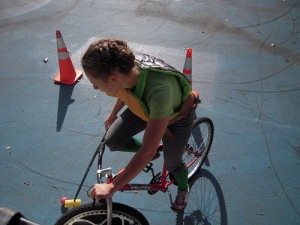At Montague we love to get people on bikes and everyone on the Montague team is passionate about bikes in some way shape or form. Today’s post is from one of Montague’s newest team members who is kind enough to share a bike experience that many aren’t familiar with but sounds like a fun time!
 Two summers ago, I was walking through Smith Playground in Allston MA. As I passed the outdoor street hockey court, I noticed that it was occupied by people on bicycles rather than rollerblades. Teams of three faced off against each other, carrying what looked like croquet mallets, trying to put a red plastic ball (about the size of a tennis ball) past orange traffic cones.
Two summers ago, I was walking through Smith Playground in Allston MA. As I passed the outdoor street hockey court, I noticed that it was occupied by people on bicycles rather than rollerblades. Teams of three faced off against each other, carrying what looked like croquet mallets, trying to put a red plastic ball (about the size of a tennis ball) past orange traffic cones.
This was my first brush with what many have come to know (and love) as bike polo.
Bike polo is pretty much what it sounds like: polo, but played on a bike instead of a horse. To make the mallets, we bolt 4-5 inches of plastic pipe (similar to PVC but heavier; PVC tends to shatter) to the end of a ski pole. We play with a hard red or orange street hockey ball.
The basic rules of polo are simple: 3 players/team and first team to score 5 goals wins. The goal is marked by orange cones, set approximately bike-width apart. A goal counts only if it is a shot – a hit off the circular end of the mallet. A shuffle, or a hit off the wide, flat side of the mallet head, does not count. Players must also remain on their bikes at all times; if a player puts his feet on the ground he is considered out and may not be involved in game play until he taps back in. Tapping in is simple – the player rides to a predetermined spot (usually the center of the court) and taps his/her mallet.
Bike polo can be played on any hard surface. In Allston, we play on a street hockey court (which is particularly nice as the boards keep the ball from going out of play) but in other cities I have played on tennis courts, parking lots, basketball courts and playgrounds. Court size varies accordingly. (To avoid confusion, I am talking about hardcourt bike polo. There is another variant of bike polo that is played on grass. The equipment and rules of grass bike polo resemble those of horse polo much more closely).
Because of the amount of physical contact in bike polo, some spectators have dubbed it “bike hockey”. But contact is fairly controlled, and limited to body-on-body, mallet-on-mallet, and bike-on-bike. For example, you may use your mallet to hook another player’s mallet in order to prevent her from playing the ball, but you may not slash another player or bike with your mallet. And obvious infractions, such as pushing another player off her bike or T-boning another player with your bike, are not allowed. Given the nature of the sport, accidents do happen, and while helmets and knee pads are not required, they are highly recommended. But the prevailing spirit of sportsmanship and fair play amongst most players makes strict enforcement of a rigid set of rules largely unnecessary.
The bike polo community in Boston is comprised of a small but dedicated group of players. Weather permitting, we even play throughout the winter, even if we have to shovel and scrape the outdoor court ourselves. We have hosted several tournaments, including the East Side Polo Invitational (ESPI) in 2009, a Hallowe’en tournament in October 2009, and the first annual Wackadoo 2 vs. 2 this September; we plan to host an indoor winter tournament in January of 2011. You can find more information about Boston Bike Polo here: www.bostonbikepolo.us, or just come out to Smith Playground in Allston any Sunday, Wednesday, or Friday. Newcomers are always welcome – bikes and mallets lent out.
Hardcourt bike polo is a growing sport throughout the world. For more information on bike polo in your area check out www.leagueofbikepolo.com.
Have you experienced bike polo? Better yet, played bike polo on your Montague? Let us know in the comments below!

